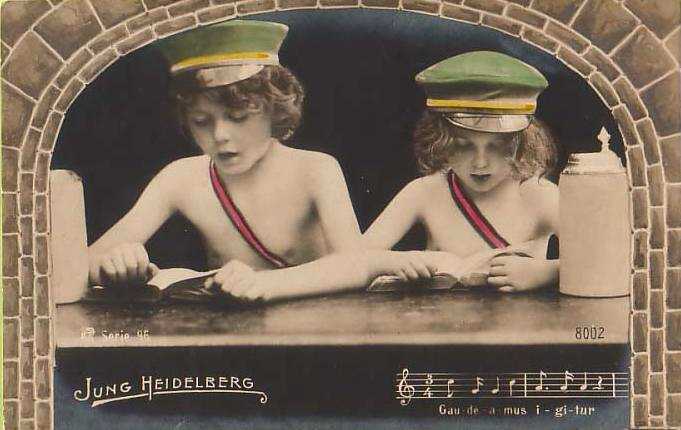
German University Associations: Studentika

Figure 1.--We note all kinds of German postcards in the early 20th century of younger children dressed up in the regalia of German university student associations--often drinking fraterities or clubs. (Notice the beer steins.) The song these are singing is "Jung Heidelberg" or Young Heildeberg, presumably the Heidelberh University song. The boys here are singing Studentika songs and are dressed with university student caps and sashes. A German reader tells us, "I guess it is the same thing like those silly postcards where little boys are dressed up as soldiers." The postcard here was published about 1904. This was one of a series with several different poses and songs. Sometimes the colors of the hat were changed.
|
One of the interesting developments of the German universities beside their academic prestige was the development of the university student movement in the 19th early 20th century. There were many university student leagues and fraternity in Germany. They had their rites and traditions. We have some information on these studentische Verbindungen or brotherhoods. A German reader tells us that, "Still today there are a few of these association left. Memorabilia about those gone days of university students are well loved collectibles today. We call all this stuff Studentika.
German Universities
Germany is also notable for the development of some of the most prestigious universities in the world. German was in the 19th century perhaps the most respected cointry in the world in terna of universitty education and research. The American Ph.D. is a degree derived from the German university tradition. Europeans from throughout central and eastern Europe came to Germany to study in universities there. Americans a studied in German universities. German was a major language for international science, one of the reasons it was in the curiculum of schools around the world, including America. This changed in the 20th century. World War I affected the universities somewhat. Fewer Europeans as well as Americans attended German Universuities. The teaching of German as a foreign language declined in America. World War II had even more of an affect. German universities were hot beds for the rising NAZI Party. NAZI policies of driving out Jews and independent thinkers also adversely affected German universities. Many university professors and other intelectuals forced to leave Germany came to America and had an important role in strenghtening the American university system. German universities today are strong competent and respected institutions, but do not have the luster that the universities had in the 19th century. Another factor has been the growth of English as a language for international science.
Germany is also notable for the development of some of the most prestigious universities in the world. The American Ph.D. is a degree derived from the German university tradition. One of the notable development of the German universities beside their academic prestige was the development of the university drinking clubs or brotherhoods. These drinking clubs were an important part of German school life. Our knowledge of these clubs is limited. Hopfully our German readers will provide some additional insights.
Studentika
A German reader tells us that, "Still today there are a few of these university association left. Memorabilia about those gone days of university students are well loved collectibles today. We call all this stuff Studentika. We note all kinds of postcards in the early 20th century of younger children dressed up in the regalia of these associations." These images were intended a humerous or warm-hearted depiction of these associations. Our German reader tells us, "The boys in the post card here are singing Studentika songs and are dressed with university student caps and this thing around their chest. I guess it is the same thing like those silly postcards where little boys are dressed up as soldiers." The song these are singing is "Jung Heidelberg" or Young Heildeberg, presumably the Heidelberh University song. German schools did not normally have uniforms, but each university had destinctive caps. Color detailing might indicate the year that they were in. The caps worn by students in secondary schools are based on these university caps. Here we see boys wearing them. The sashes were more ceremonial in nature. Notice the beer steins. This was a tradition adopted by American fraternities. American university fraternities are another German influence on American education.
HBC

Related Chronolgy Pages in the Boys' Historical Web Site
[Main Chronology Page]
[The 1880s]
[The 1930s]
[The 1940s]
[The 1950s]
[The 1960s]
[The 1970s]
[The 1980s]
Related Style Pages in the Boys' Historical Web Site
[Main school uniform page]
[Main country page]
[Long pants suits]
[Short pants suits]
[Socks]
[Eton suits]
[Jacket and trousers]
[Blazer
[School sandals]
Navigate the Boys' Historical Clothing School Uniform Pages
Main German school level page]
[Main German school uniform Page]
[Australia]
[England]
[France]
[Italy]
[Japan]
[New Zealand]
[Scotland]
[United States]
Navigate the Boys' Historical Clothing Web Page
[Introduction]
[Activities]
[Biographies]
[Chronology]
[Clothing styles]
[Countries]
[Bibliographies]
[Contributions]
[FAQs]
[Glossaries]
[Satellite sites]
[Tools]
[Boys' Clothing Home]
Created: 8:58 PM 2/14/2006
Last updated: 8:58 PM 2/14/2006



